Numerical Analysis of the Crown Displacements Caused by Tunnel Excavation with Rock Bolts
Abstract
:1. Introduction
2. Literature Review
3. Project Overview of the Case Study
3.1. Highway Tunnels in Taiwan
3.2. Tunnel Excavation and Support
4. Numerical Analysis and Calculations
4.1. Tunnel Numerical Analysis Process
4.2. Mohr–Coulomb Model
4.3. Hoek–Brown Model
4.4. Linear Elasticity Model
5. Numerical Analysis Results
5.1. Analysis Results of the Mohr–Coulomb Rock Material Model
5.2. Analysis Results of the Hoek–Brown Rock Material Model
5.3. Rock Bolt Benefit Analysis
5.4. Normalized Displacement Analysis
5.5. Validation of the Constructed Models
6. Conclusions
- (1)
- The numerical analysis results did not show any distinct difference between the Mohr–Coulomb and Hoek–Brown models. The distribution of longitudinal deformation profiles along the tunnels was generally similar. Therefore, the careful selection of analytic methods and parameters should result in either model being suitable for numerical analysis.
- (2)
- The tunnel cross section and the geology play significant roles in the tunnel excavation deformation behavior. In general, tunnels with large cross sections located in poor rock masses tended to exhibit large displacements due to excavation; in contrast, the displacements tended to be smaller for tunnels with small cross sections located in good rock masses. Moreover, the poorer the rock mass, the more significant the reduction effect caused by the installation of rock bolts for the displacements in tunnels with large cross sections.
- (3)
- It is extremely difficult to analyze rock bolts in a model. As the modeling of rock bolts is so complex, they are generally ignored. In this study, the actual on-site construction situation was considered, and the built model included comparisons of tunnels with and without rock bolts. In general, it is rare for research to explore the differences between these types of tunnels and provide specific comparative results.
- (4)
- The excavation face displacement ratio (uz-f/uz-max) depends on the quality of the rock mass. In the case of this study, the values of uz-f/uz-max were 0.39, 0.39, and 0.49 for good, medium, and poor rock masses, respectively.
- (5)
- Ignoring time-dependent factors, the excavation face displacement ratio (uz-f/uz-max) was between 0.31 and 0.57 for the tunnels studied, and the poorer the geology, the higher the ratio. The displacement ratio increased dramatically within a distance of half the diameter (−0.5 Dequ) behind the excavation face (the excavated section), and the excavation-induced displacement reached its maximum at twice the diameter (−2 Dequ) behind the excavation face, with the displacement ratio approaching 1.
- (6)
- In the excavated section, the displacement ratio derived according to the prediction formula of Unlu and Gercek was smaller than the numerical analysis result, and the distance of the estimated maximum displacement to the excavation face was greater than 4 times the diameter of the tunnel. At the excavation face, the displacement ratio derived according to the formula of Unlu and Gercek was also smaller than the numerical analysis result, and the difference between the two became larger as the rock mass decreased in quality. Within a distance of about 0.25 to 2.5 diameters ahead of the excavation face, the numerical results tended to fall into a lower range than the ratios predicted by the formula of Unlu and Gercek.
- (7)
- Geology is one of the most important factors to consider in the excavation of a tunnel. In addition to the geological knowledge of engineers, the job site survey carried out before engineering planning and design should be performed as carefully as possible. Relevant rock mass classification and measurement operations should also establish standard operating procedures to maintain a good construction quality.
Author Contributions
Funding
Institutional Review Board Statement
Informed Consent Statement
Data Availability Statement
Acknowledgments
Conflicts of Interest
References
- Zheng, H.; Li, P.; Ma, G.; Zhang, Q. Experimental investigation of mechanical characteristics for linings of twins tunnels with asymmetric crosssection. Tunn. Undergr. Space Technol. 2021, 119, 104209. [Google Scholar] [CrossRef]
- Chen, H.; Li, L.; Li, J.; Sun, D. A Generic Analytical Elastic Solution for Excavation Responses of an Arbitrarily Shaped Deep Opening under Biaxial In Situ Stresses. Int. J. Geomech. 2022, 22, 04022023. [Google Scholar] [CrossRef]
- Weng, X.; Yu, H.; Niu, H.; Hu, J.; Han, W.; Huang, X. Interactive effects of crossing tunnel construction on existing tunnel: Three-dimensional centrifugal test and numerical analyses. Transp. Geotech. 2022, 35, 100789. [Google Scholar] [CrossRef]
- Liu, X.; Zeng, Y.; Fan, L.; Peng, S.; Liu, Q. Investigation on Rupture Initiation and Propagation of Traffic Tunnel under Seismic Excitation Based on Acoustic Emission Technology. Sensors 2022, 22, 4553. [Google Scholar] [CrossRef]
- Zeng, G.S.; Wang, H.N.; Jiang, M.J.; Luo, L.S. Analytical solution of displacement and stress induced by the sequential excavation of noncircular tunnels in viscoelastic rock. Int. J. Rock Mech. Min. Sci. 2020, 134, 104429. [Google Scholar] [CrossRef]
- Cao, C.; Shi, C.; Lei, M.; Yang, W.; Liu, J. Squeezing failure of tunnels: A case study. Tunn. Undergr Space Technol. 2018, 77, 188–203. [Google Scholar] [CrossRef]
- Duenser, C.; Beer, G. Simulation of sequential excavation with the boundary element method. Comput. Geotech. 2012, 44, 157–166. [Google Scholar] [CrossRef]
- Luo, Y.; Chen, J.; Chen, Y.; Diao, P.; Qiao, X. Longitudinal deformation profile of a tunnel in weak rock mass by using the back analysis method. Tunn. Undergr. Space Technol. 2018, 71, 478–493. [Google Scholar] [CrossRef]
- Riedel, C.; Mahmoudi, E.; Trapp, M.; Lamert, A.; Hölter, R.; Zhao, C.; Musayev, K.; Baitsch, M.; König, M.; Hackl, K.; et al. A hybrid exploration approach for the prediction of geological changes ahead of mechanized tunnel excavation. J. Appl. Geophys. 2022, 203, 104684. [Google Scholar] [CrossRef]
- Hoek, E.; Marinos, P.; Benissi, M. Applicability of the geological strength index (GSI) classification for very weak and sheared rock masses. The case of the Athens Schist Formation. Bull. Eng. Geol. Environ. 1998, 57, 151–160. [Google Scholar] [CrossRef]
- Hoek, E.; Brown, E.T. Empirical strength criterion for rock masses. J. Geotech. Eng. Div. 1980, 106, 1013–1035. [Google Scholar] [CrossRef]
- Cheng, X.; Hong, T.; Lu, Z.; Cheng, X. Characterization of Underlying Twin Shield Tunnels Due to Foundation-Excavation Unloading in Soft Soils: An Experimental and Numerical Study. Appl. Sci. 2021, 11, 10938. [Google Scholar] [CrossRef]
- Huang, X.; Schweiger, H.F.; Huang, H.W. Influence of deep excavations on nearby existing tunnels. Int. J. Geomech. 2013, 13, 170–180. [Google Scholar] [CrossRef]
- Zhang, J.F.; Chen, J.J.; Wang, J.H.; Zhu, Y.F. Prediction of tunnel displacement induced by adjacent excavation in soft soil. Tunn. Undergr. Space Technol. 2013, 36, 24–33. [Google Scholar] [CrossRef]
- Zhang, X.; Wei, G.; Jiang, C. The study for longitudinal deformation of adjacent shield tunnel due to foundation pit excavation with consideration of the retaining structure deformation. Symmetry 2020, 12, 2103. [Google Scholar] [CrossRef]
- Han, K.; Wang, X.; Hou, B.; Lin, X.; Cao, C. Analysis of Instability Mode and Limit Support Pressure of Shallow Tunnel Face in Sands. Symmetry 2020, 12, 2067. [Google Scholar] [CrossRef]
- Carranza-Torres, C.; Fairhurst, C. Application of the convergence-confinement method of tunnel design to rock masses that satisfy the Hoek-Brown failure criterion. Tunn. Undergr. Space Technol. 2000, 15, 187–213. [Google Scholar] [CrossRef]
- Song, S.G.; Li, S.C.; Li, L.P.; Zhang, Q.Q.; Wang, K.; Zhou, Y.; Liu, H.L. Study on longitudinal deformation profile of rock mass in a subsea tunnel. Mar. Georesour. Geotechnol. 2016, 34, 376–383. [Google Scholar] [CrossRef]
- Basarir, H.; Genis, M.; Ozarslan, A. The analysis of radial displacements occurring near the face of a circular opening in weak rock mass. Int. J. Rock Mech. Min. Sci. 2010, 47, 771–783. [Google Scholar] [CrossRef]
- Brady, B.H.G.; Brown, E.T. Rock Mechanics for Underground Mining, 2nd ed.; Chapman and Hall: London, UK, 1993. [Google Scholar]
- Unlu, T.; Gercek, H. Effect of Poisson’s ratio on the normalized radial displacements occurring around the face of a circular tunnel. Tunn. Undergr. Space Technol. 2003, 18, 547–553. [Google Scholar] [CrossRef]
- Prassetyo, S.H.; Gutierrez, M. Axisymmetric alternating direction explicit scheme for efficient coupled simulation of hydro-mechanical interaction in geotechnical engineering—Application to circular footing and deep tunnel in saturated ground. J. Rock Mech. Geotech. Eng. 2018, 10, 259–279. [Google Scholar] [CrossRef]
- Panet, M. Understanding Deformations in Tunnels. In Comprehensive Rock Engineering; Pergamon: London, UK, 1993; Volume 1, pp. 663–690. [Google Scholar]
- Ziaei, A.; Ahangari, K. The Effect of Topography on Stability of Shallow Tunnels Case Study: The Diversion and Conveyance Tunnels of Safa Dam. Transp. Geotech. 2018, 14, 126–135. [Google Scholar] [CrossRef]
- Carranza-Torres, C.; Fairhurst, C. The elasto-plastic response of underground excavations in rock masses that satisfy the Hoek±Brown failure criterion Tunn. Int. J. Rock Mech. Min. Sci. 1999, 36, 777–809. [Google Scholar] [CrossRef]
- Kavvadas, M.; Litsas, D.; Vazaios, I.; Fortsakis, P. Development of a 3D finite element model for shield EPB tunnelling. Tunn. Undergr. Space Technol. 2017, 65, 22–34. [Google Scholar] [CrossRef]
- Deng, H.; Cao, P.; Liu, Y.; Liu, Z.; Meng, G.; Fan, Z.; Xie, W. Numerical Analysis of Ground Settlement Patterns Resulting from Tunnel Excavation in Composite Strata. Appl. Sci. 2022, 12, 5479. [Google Scholar] [CrossRef]
- Abdelkader, E.M.; Al-Sakkaf, A.; Elshaboury, N.; Alfalah, G. Hybrid Grey Wolf Optimization-Based Gaussian Process Regression Model for Simulating Deterioration Behavior of Highway Tunnel Components. Processes 2021, 10, 36. [Google Scholar] [CrossRef]
- National Expressway Engineering Bureau, Ministry of Transportation and Communications. Technical Practice of National Highway Geoengineering; National Expressway Engineering Bureau, Ministry of Transportation and Communications: Taipei, Taiwan, 2013; pp. 87–140. (In Chinese)
- National Expressway Engineering Bureau, Ministry of Transportation and Communications. Second Highway Construction Album-Tunnel and Geoengineering; National Expressway Engineering Bureau, Ministry of Transportation and Communications: Taipei, Taiwan, 2004; pp. 68–72. (In Chinese)
- Lee, S.; Tseng, D. Review and perspective of expressway tunnels in Taiwan. J. Rock Mech. Geotech. Eng. 2011, 3, 385–387. [Google Scholar]
- Bieniawski, Z.T. Engineering Rock Mass Classification; John Wiley & Sons: New York, NY, USA, 1989; pp. 51–68. [Google Scholar]
- Chen, S.; Lee, S.; Gui, M.W. Effect of rock pillar width on the excavation behavior of parallel tunnels. Tunn. Undergr. Space Technol. 2009, 24, 148–154. [Google Scholar] [CrossRef]
- Chen, S.L.; Lee, S.C. An investigation on tunnel deformation behavior of expressway tunnels. Geomech. Eng. 2020, 21, 215–226. [Google Scholar]
- Lai, C.H. Three-Dimensional Numerical Analysis of Mountain Tunnels-Simulation of Crown Arch Displacement Using Data from Existing Tunnels in Taiwan. Master’s Thesis, National Taipei University of Technology, Taipei, Taiwan, 2020. (In Chinese). [Google Scholar]
- PLAXIS 3D Reference Manual. 2018. Available online: https://pdfcoffee.com/plaxis-3d-reference-manual-2018-pdf-free.html (accessed on 20 May 2021).
- National Expressway Engineering Bureau, Ministry of Transportation and Communications. Beiyi Expressway Construction Special (Technical Edition)-Tunnel Engineering; National Expressway Engineering Bureau, Ministry of Transportation and Communications: Taipei, Taiwan, 2006; pp. 59–60. (In Chinese)
- Brinkgreve, R.B.J.; Kumarswamy, S.; Swolfs, W.M. Plaxis Material Models Manual; Plaxis B.V.: Delft, The Netherlands, 2017; pp. 35–53. [Google Scholar]
- Erik, E. The Hoek-Brown failure criterion. Rock Mech. Rock Eng. 2012, 45, 981–988. [Google Scholar]
- Hoek, E.; Carranza, C.; Corkum, B. Hoek-Brown failure criterion-2002 edition. Proc. NARMS-Tac. 2002, 1, 267–273. [Google Scholar]
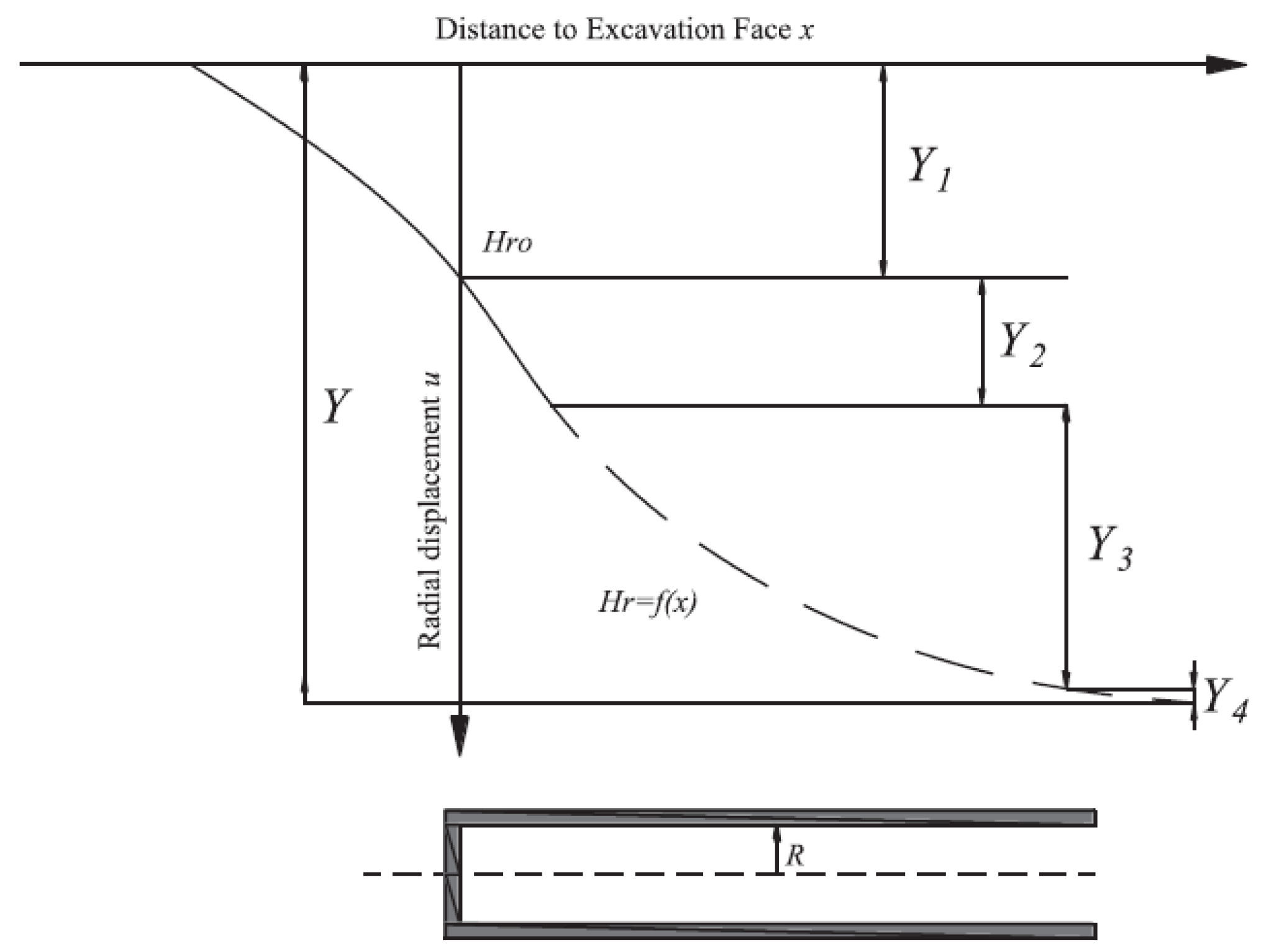
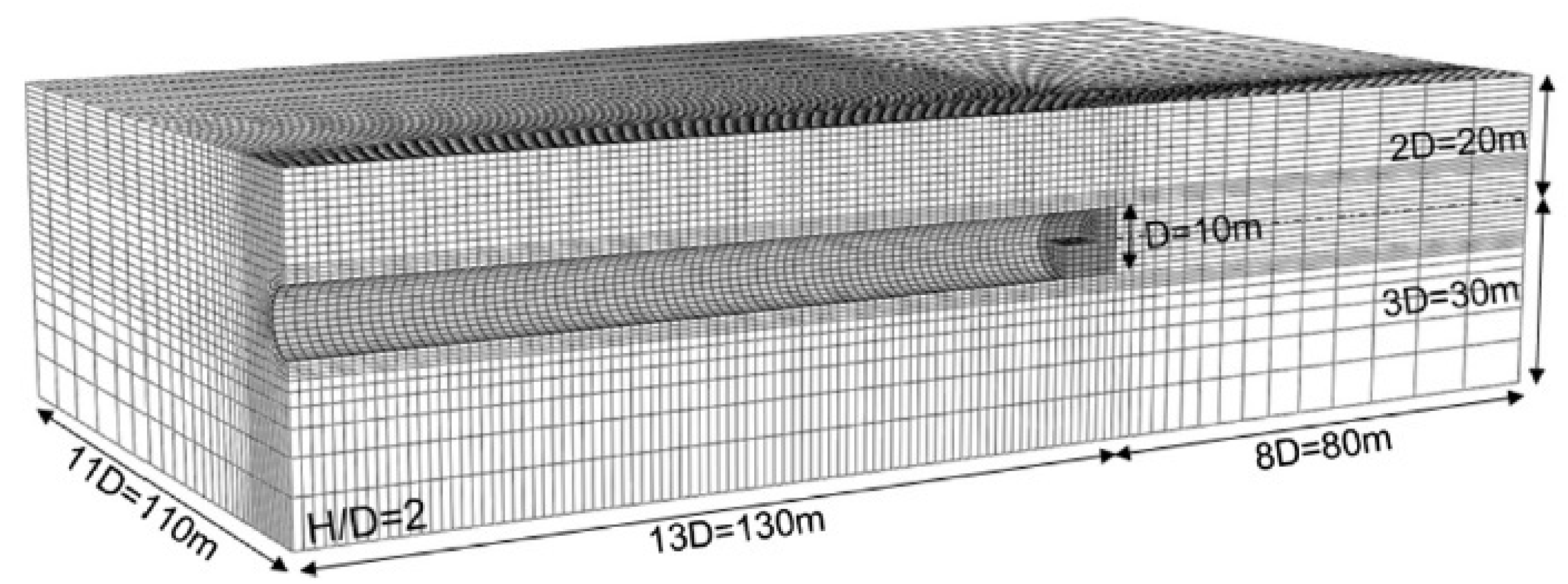
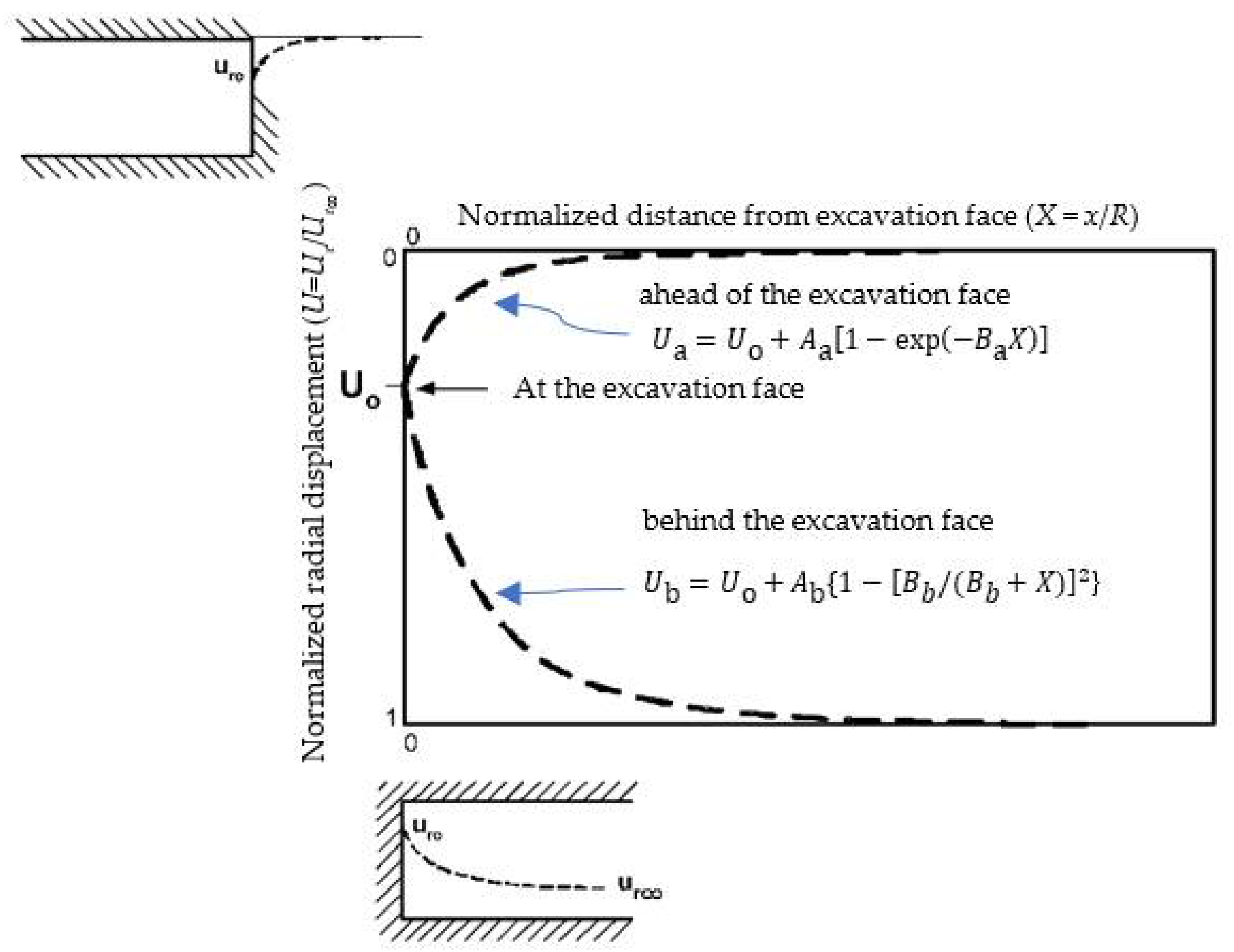

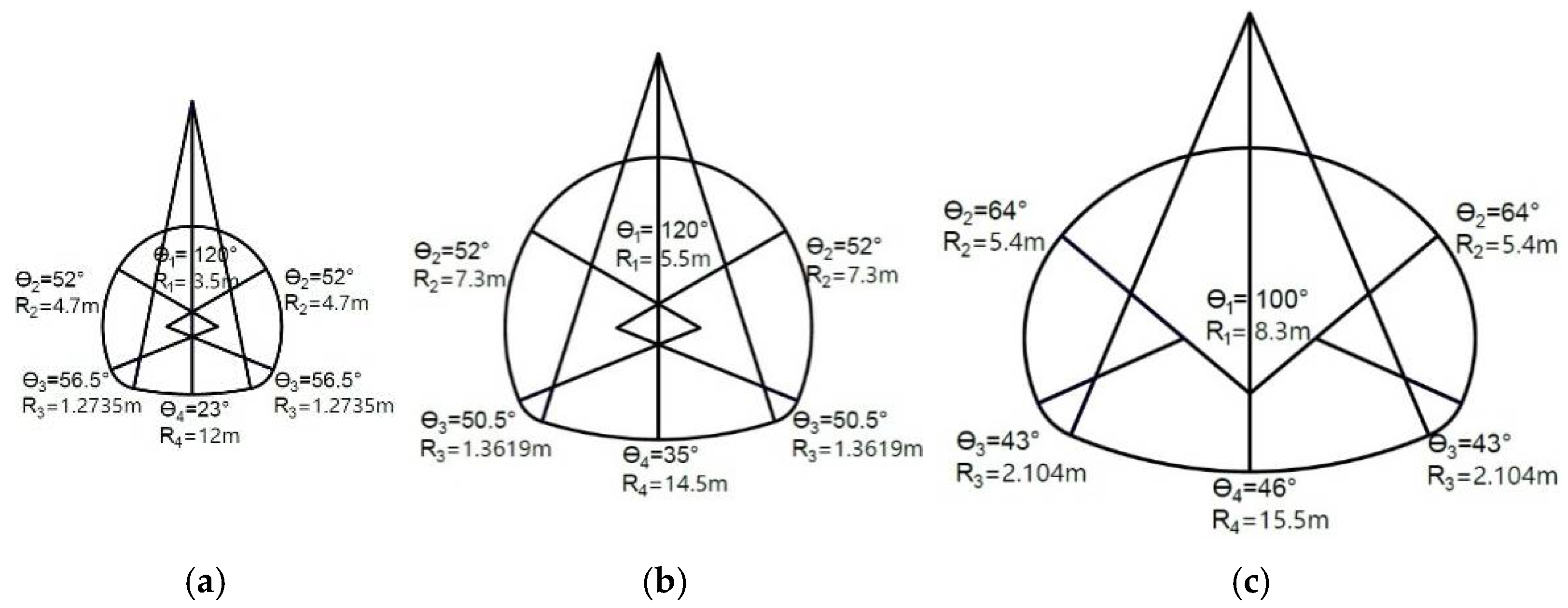
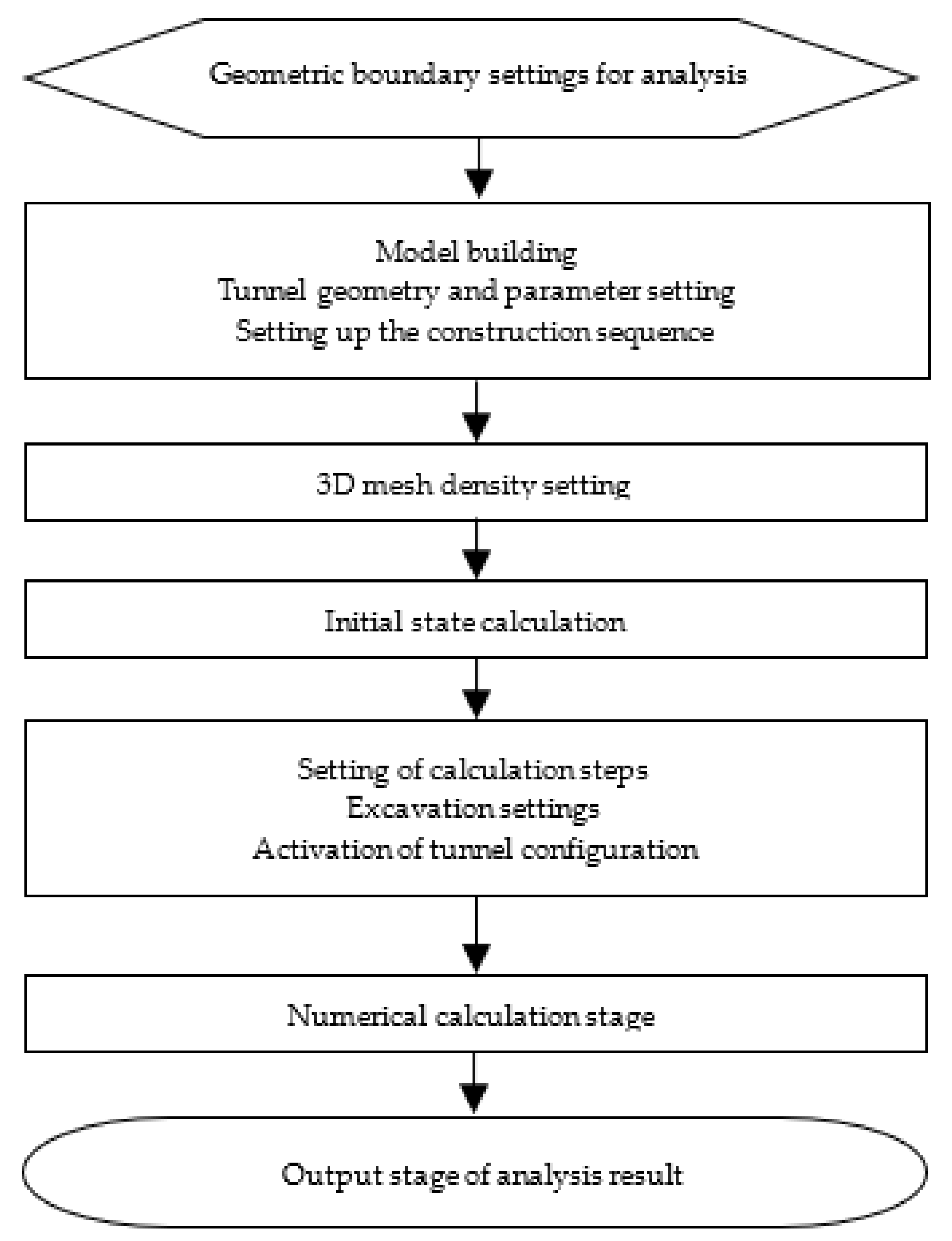

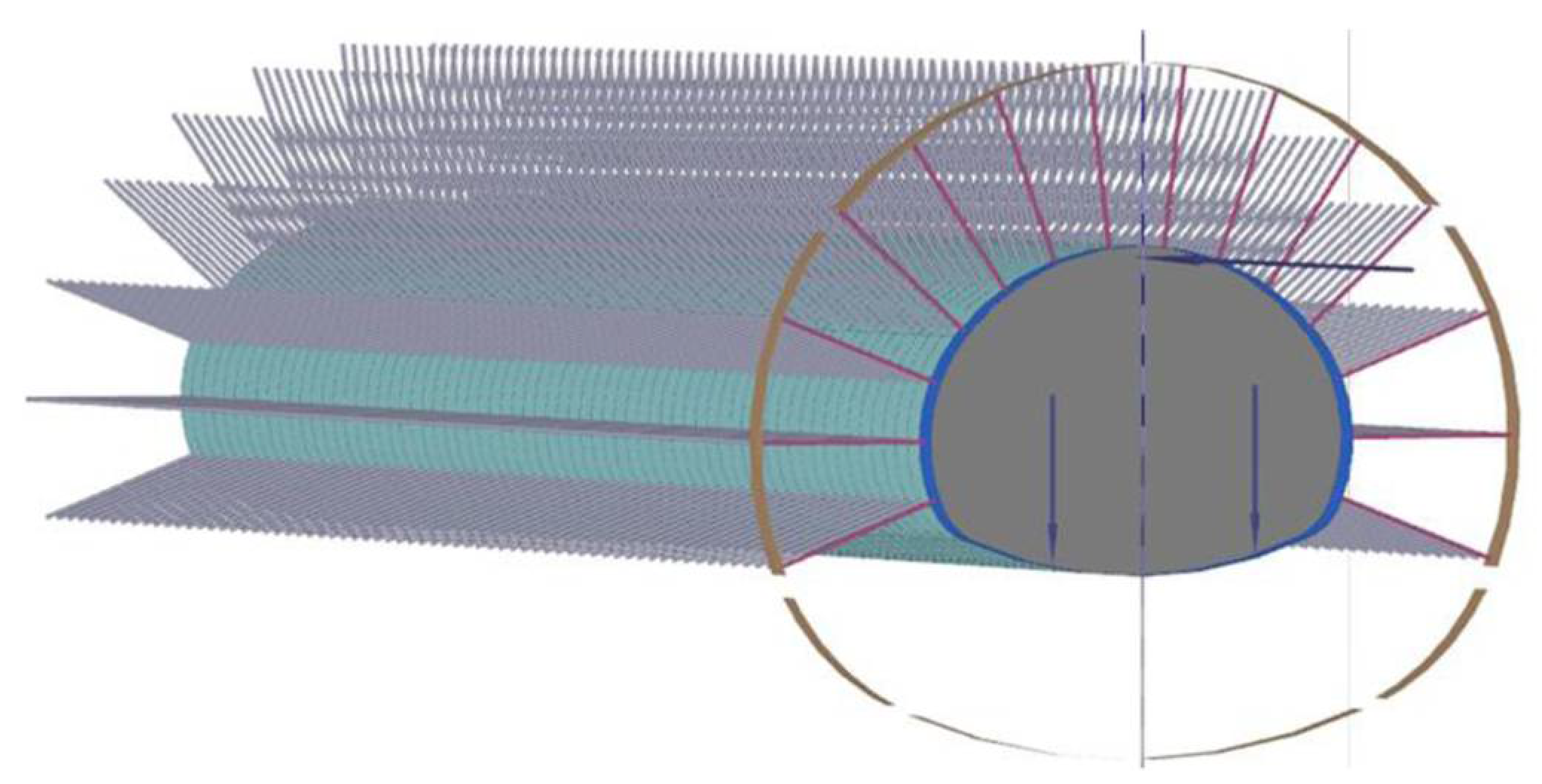
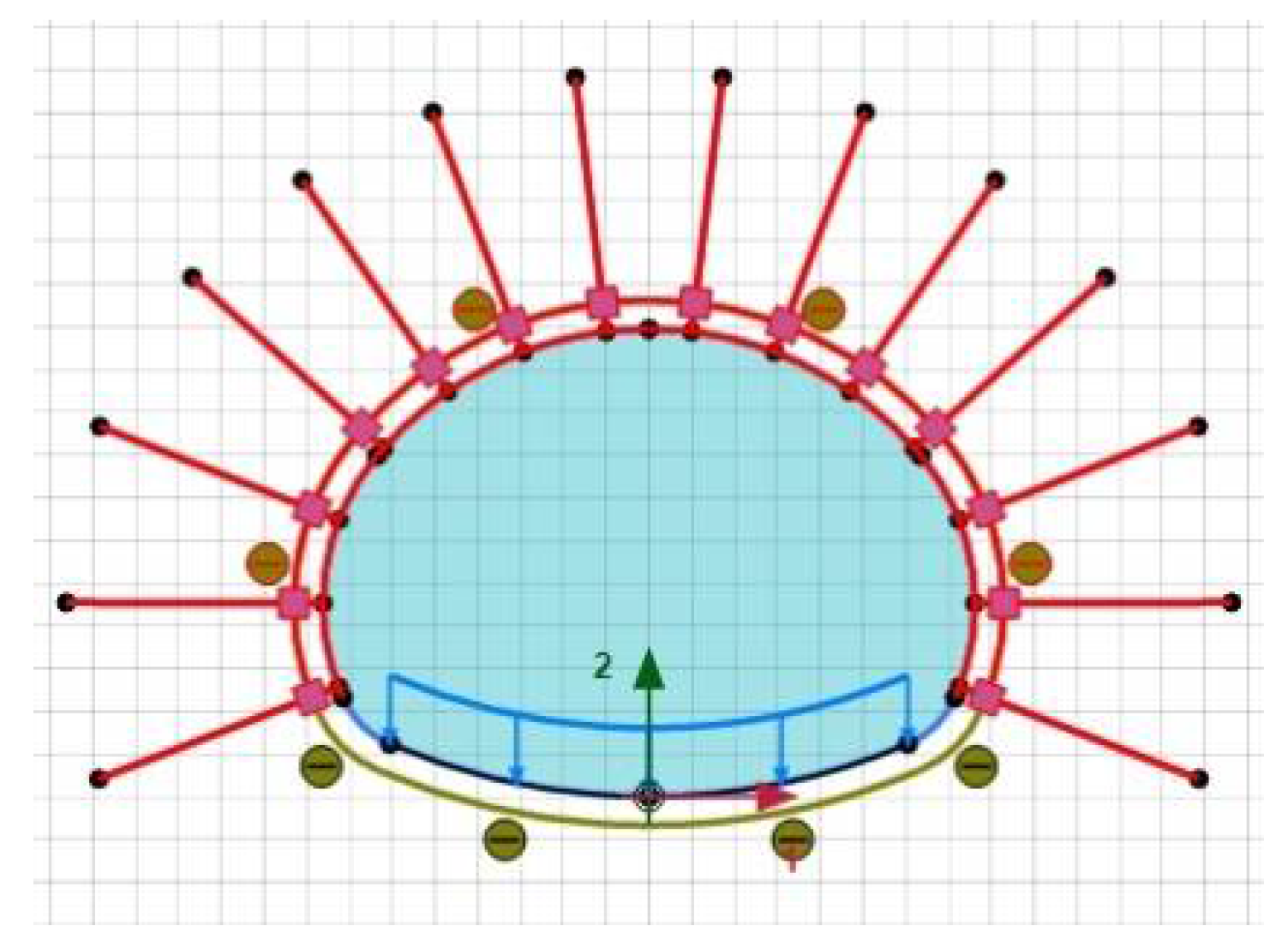



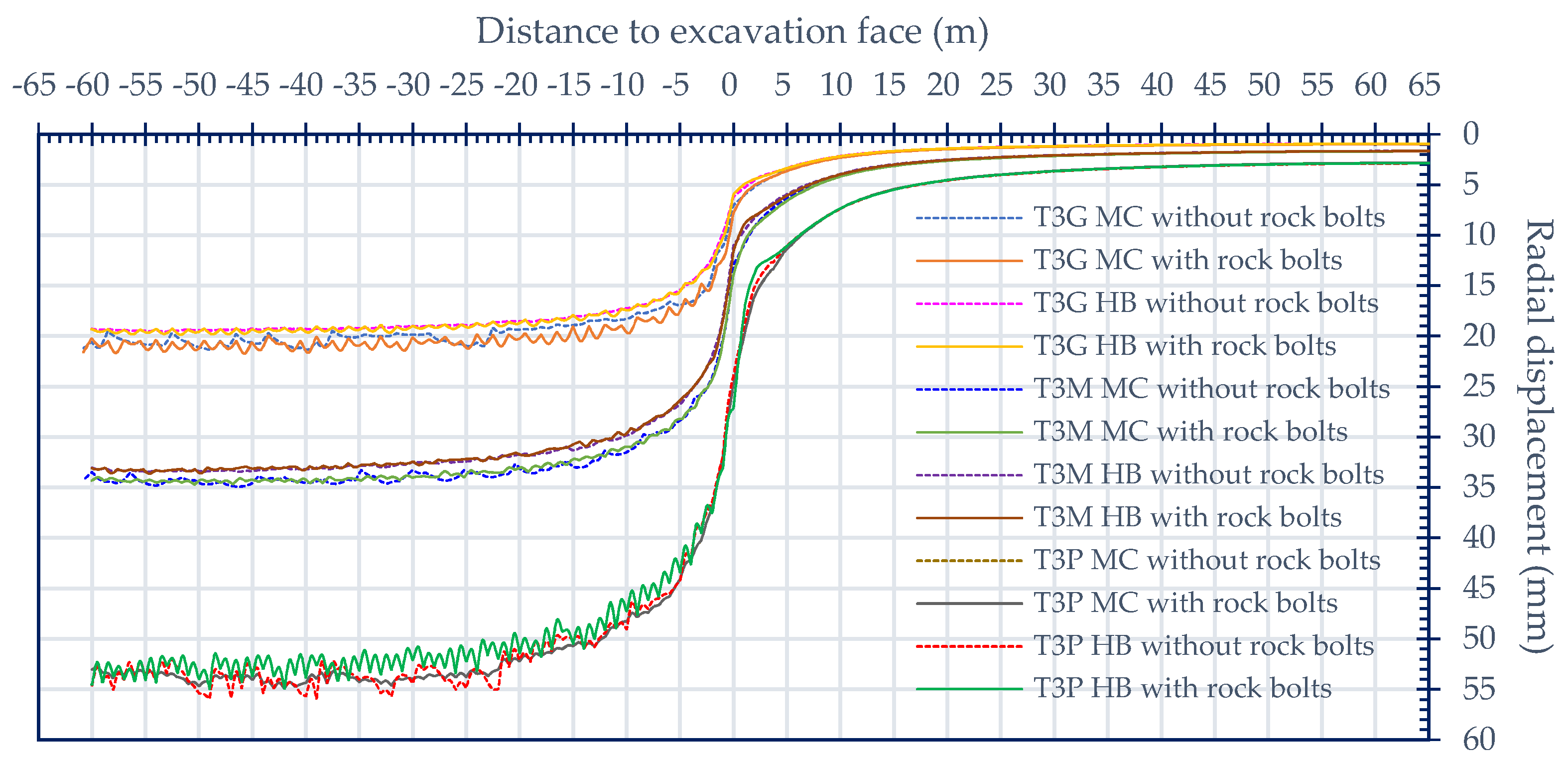
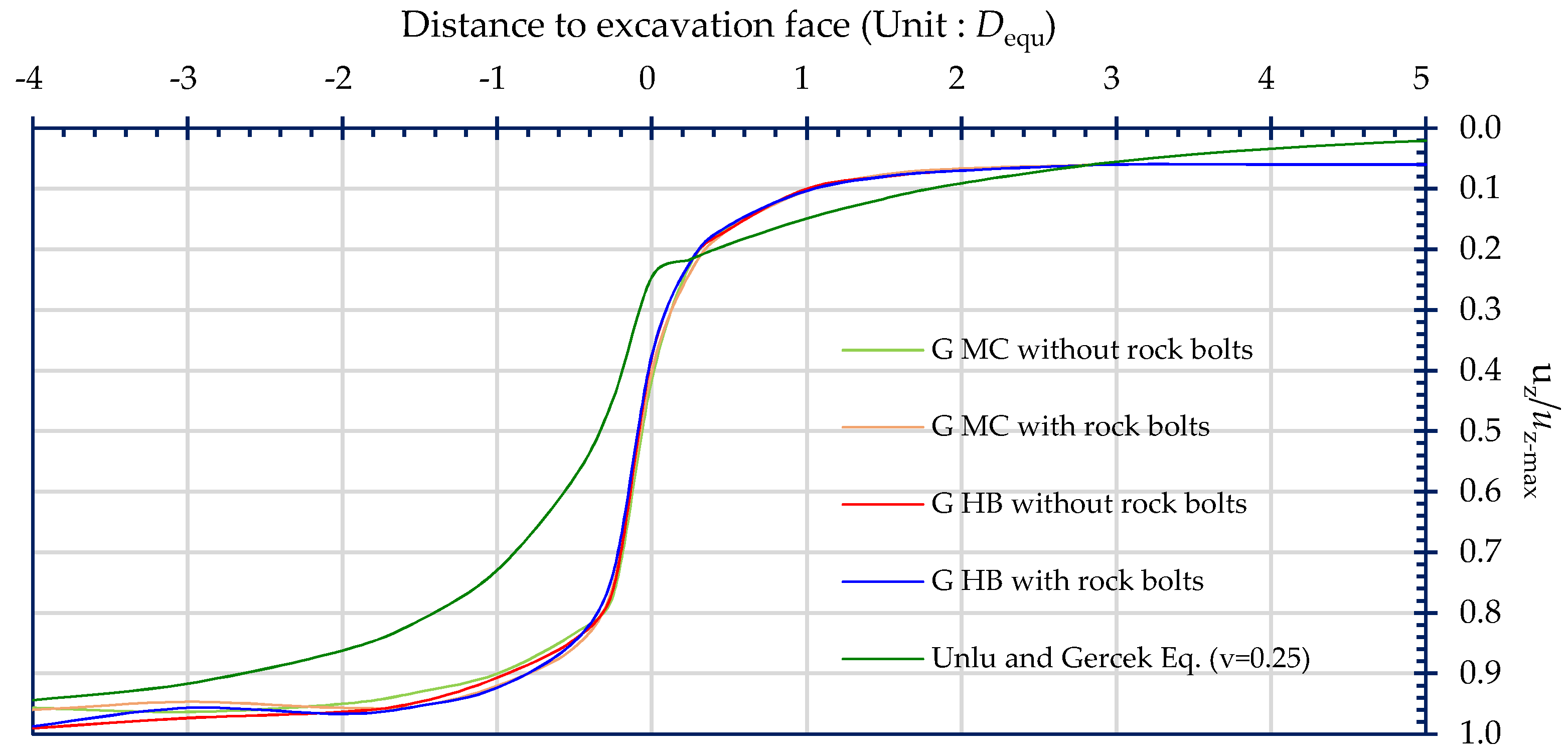
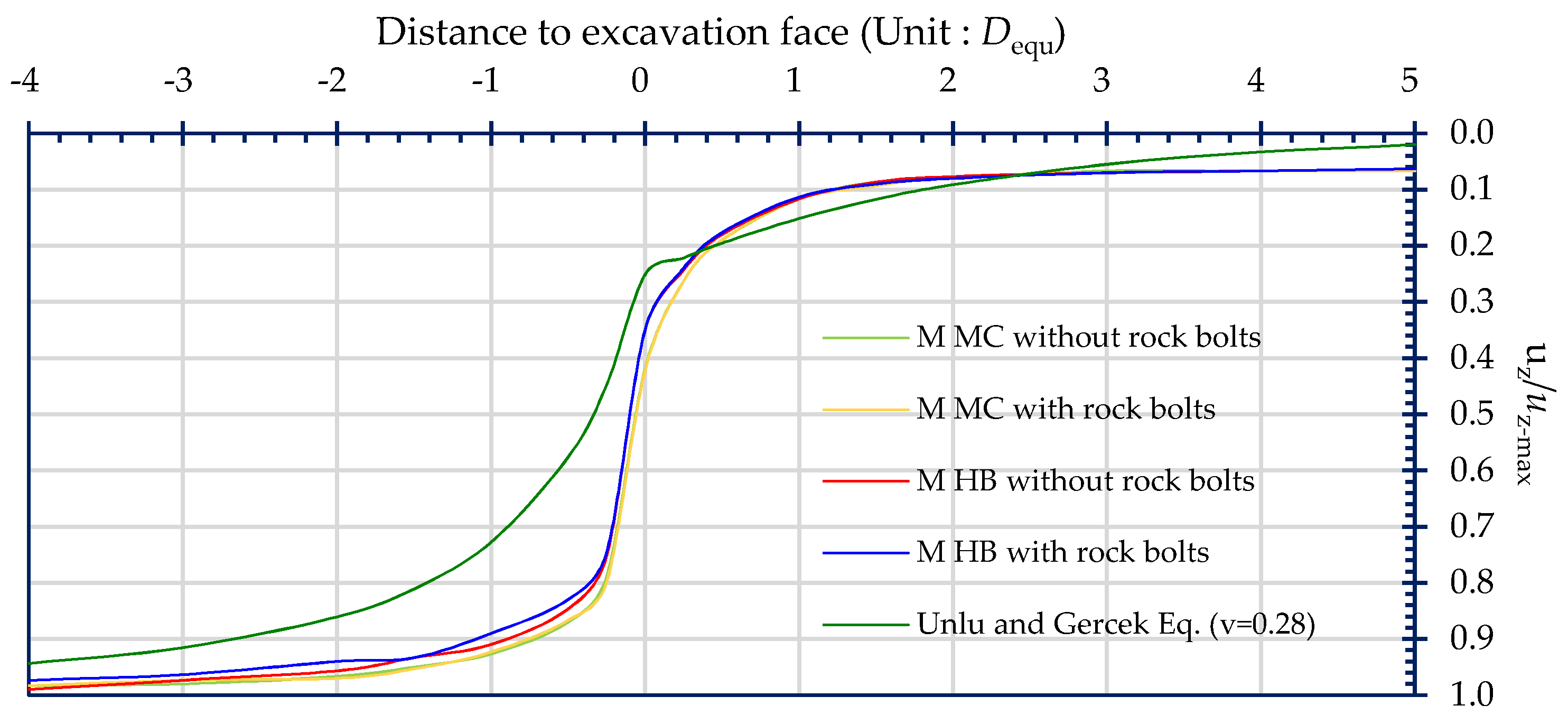
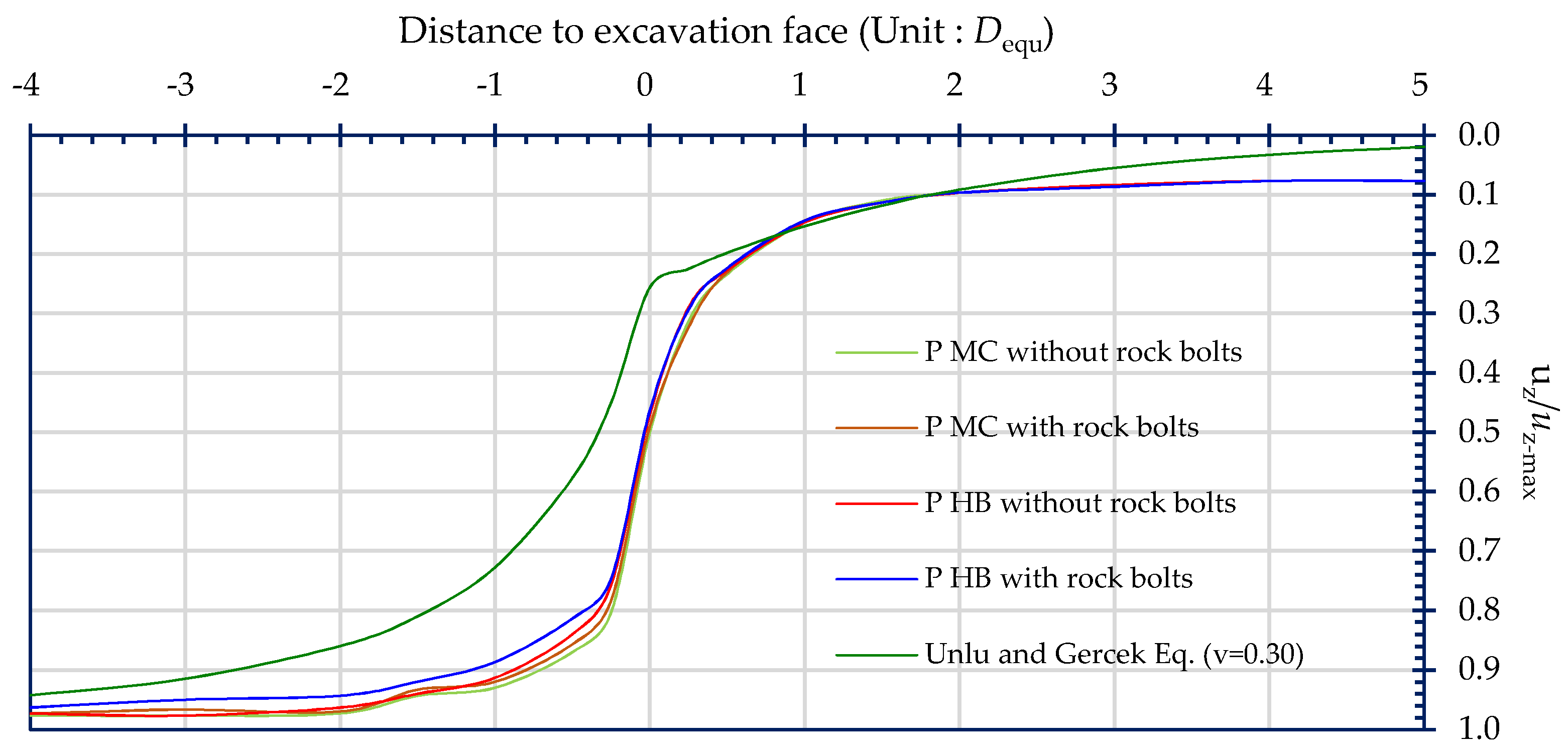
| Rock Mass Rating | I | II | III | IV | V | VI |
|---|---|---|---|---|---|---|
| RMR | 100–81 | 80–61 | 60–41 | 40–21 | 20–11 | 10–0 |
| Rock Quality | Good | Medium | Poor | |||
| Tunnel Cross Section | Cross-Sectional Area (m2) | Equivalent Diameter (m) | Rock Condition | Tunnel Symbol | Round Length (m) | Shotcrete Thickness (m) |
|---|---|---|---|---|---|---|
| Single-lane | 41.69 | 7.29 | Good | T1G | 2.0 | 0.12 |
| Medium | T1M | 1.8 | 0.15 | |||
| Poor | T1P | 1.5 | 0.25 | |||
| Two-lane | 100.35 | 11.3 | Good | T2G | 1.8 | 0.15 |
| Medium | T2M | 1.5 | 0.20 | |||
| Poor | T2P | 1.2 | 0.30 | |||
| Three-lane | 133.76 | 13.05 | Good | T3G | 1.5 | 0.20 |
| Medium | T3M | 1.2 | 0.25 | |||
| Poor | T3P | 1.0 | 0.35 |
| Parameter | Unit | Rock Condition | ||
|---|---|---|---|---|
| Good (G) | Medium (M) | Poor (P) | ||
| Dry unit weight of rock, γdry | kN/m3 | 23 | 23 | 23 |
| Wet unit weight of rock, γwet | kN/m3 | 25 | 25 | 25 |
| Deformation modulus of rock, Em | kN/m2 | 2,000,000 | 1,000,000 | 500,000 |
| 0.25 | 0.28 | 0.3 | ||
| Cohesion, c | kN/m2 | 300 | 150 | 100 |
| Angle of friction, φ | ° | 33 | 29 | 26 |
| Dilatancy angle, ψ | ° | 3 | 0 | 0 |
| Lateral stress coefficient, K0 | 1 | 1 | 1 | |
| Parameter | Unit | Good (G) | Medium (M) | Poor (P) |
|---|---|---|---|---|
| Unsaturated unit weight of rock, γunsat | kN/m3 | 23 | 23 | 23 |
| Saturated unit weight of rock, γsat | kN/m3 | 25 | 25 | 25 |
| Young’s modulus of rock mass, Em | kN/m2 | 2,000,000 | 1,000,000 | 500,000 |
| - | 0.25 | 0.28 | 0.30 | |
| kN/m2 | 24,000 | 18,000 | 12,000 | |
| - | 12 | 10 | 8 | |
| Geological strength index, GSI | - | 60 | 45 | 30 |
| Rock disturbance index, D | - | 0.4 | 0.3 | 0.2 |
| = 0, ψmax | ° | 3 | 0 | 0 |
| kN/m2 | 1150 | 0 | 0 | |
| Reduction factor for interfacial strength, Rinter | - | 0.8 | 0.8 | 0.8 |
| Lateral stress coefficient, K0 | - | 1 | 1 | 1 |
| Tunnel Symbol | T1G | T1M | T1P | T2G | T2M | T2P | T3G | T3M | T3P |
|---|---|---|---|---|---|---|---|---|---|
| Shotcrete thickness (m) | 0.12 | 0.15 | 0.25 | 0.15 | 0.20 | 0.30 | 0.20 | 0.25 | 0.35 |
| Unit weight (kN/m3) | 24 | ||||||||
| Young’s modulus (kN/m2) | 2.4 × 107 | ||||||||
| 0.17 | |||||||||
| Tunnel Symbol | T1G | T1M | T1P | T2G | T2M | T2P | T3G | T3M | T3P |
|---|---|---|---|---|---|---|---|---|---|
| Length (m) | 4 | 4 | 4 | 5 | 5 | 5 | 6 | 6 | 6 |
| Unit weight (kN/m3) | 77 | ||||||||
| Young’s modulus (kN/m2) | 2.1 × 108 | ||||||||
| Diameter (m) | 0.05 | ||||||||
| Tunnel Symbol | Dequ (m) | uz-max (mm) | uz-max to Excavation Face (m) | 0.9 × uz-max (mm) | 0.9 × uz-max to Excavation Face (m) | uz-f (mm) | uz-f /uz-max | 0.1 × uz-max (mm) | 0.1 × uz-max to Excavation Face (m) |
|---|---|---|---|---|---|---|---|---|---|
| T1G | 7.29 | 7.74 | −21.00 | 6.97 | −5.00 | 3.32 | 0.43 | 0.77 | 8.92 |
| (−2.88 Dequ) | (−0.69 Dequ) | (1.22 Dequ) | |||||||
| T1M | 7.29 | 11.49 | −19.11 | 10.34 | −3.81 | 5.03 | 0.44 | 1.15 | 11.83 |
| (−2.62 Dequ) | (−0.52 Dequ) | (1.62 Dequ) | |||||||
| T1P | 7.29 | 14.41 | −22.26 | 12.97 | −4.99 | 8.10 | 0.56 | 1.44 | 28.69 |
| (−3.05 Dequ) | (−0.68 Dequ) | (3.93 Dequ) | |||||||
| T2G | 11.30 | 14.06 | −47.10 | 12.65 | −15.60 | 6.94 | 0.44 | 1.41 | 12.11 |
| (−4.14 Dequ) | (−1.38 Dequ) | (1.07 Dequ) | |||||||
| T2M | 11.30 | 20.46 | −32.25 | 18.41 | −8.25 | 8.96 | 0.48 | 2.05 | 14.78 |
| (−2.85 Dequ) | (−0.73 Dequ) | (1.31 Dequ) | |||||||
| T2P | 11.30 | 26.45 | −38.40 | 23.81 | −6.30 | 12.73 | 0.49 | 2.65 | 23.92 |
| (−3.4 equ) | (−0.56 Dequ) | (2.12 Dequ) | |||||||
| T3G | 13.05 | 21.33 | −48.76 | 19.20 | −17.26 | 3.32 | 0.33 | 2.13 | 11.09 |
| (−3.74 Dequ) | (−1.32 Dequ) | (0.85 Dequ) | |||||||
| T3M | 13.05 | 34.90 | −46.21 | 31.41 | −12.01 | 5.05 | 0.37 | 3.49 | 12.29 |
| (−3.54 Dequ) | (−0.92 Dequ) | (0.94 Dequ) | |||||||
| T3P | 13.05 | 54.89 | −42.01 | 49.40 | −11.98 | 8.10 | 0.45 | 5.49 | 14.79 |
| (−3.22 Dequ) | (−0.92 Dequ) | (1.13 Dequ) |
| Tunnel Symbol | Dequ (m) | uz-max (mm) | uz-max to Excavation Face (m) | 0.9 × uz-max (mm) | 0.9 × uz-max to Excavation Face (m) | uz-f (mm) | uz-f /uz-max | 0.1 × uz-max (mm) | 0.1 × uz-max to Excavation Face (m) |
|---|---|---|---|---|---|---|---|---|---|
| T1G | 7.29 | 7.52 | −29.01 | 6.77 | −6.41 | 2.58 | 0.34 | 0.75 | 8.24 |
| (−3.98 Dequ) | (−0.88 Dequ) | (1.13 Dequ) | |||||||
| T1M | 7.29 | 11.06 | −19.11 | 9.95 | −5.6 | 4.09 | 0.37 | 1.11 | 11.36 |
| (−2.62 Dequ) | (−0.77 Dequ) | (1.56 Dequ) | |||||||
| T1P | 7.29 | 14.42 | −18.51 | 12.98 | −7.26 | 7.54 | 0.52 | 1.44 | 27.96 |
| (−2.54 Dequ) | (−1.00 Dequ) | (3.84 Dequ) | |||||||
| T2G | 11.3 | 12.94 | −47.1 | 11.65 | −9.3 | 6.03 | 0.47 | 1.29 | 12.09 |
| (−4.17 Dequ) | (−0.82 Dequ) | (1.07 Dequ) | |||||||
| T2M | 11.3 | 19.36 | −45.75 | 17.42 | −9.42 | 6.85 | 0.35 | 1.94 | 14.78 |
| (−4.05 Dequ) | (−0.83 Dequ) | (1.31 Dequ) | |||||||
| T2P | 11.3 | 26.35 | −31.8 | 23.72 | −8.62 | 11.72 | 0.44 | 2.64 | 24.53 |
| (−2.81 Dequ) | (−0.76 Dequ) | (2.17 Dequ) | |||||||
| T3G | 13.05 | 19.55 | −53.28 | 17.6 | −11.64 | 6.17 | 0.32 | 1.96 | 11.48 |
| (−4.08 Dequ) | (−0.89 Dequ) | (0.88 Dequ) | |||||||
| T3M | 13.05 | 33.43 | −54.59 | 30.09 | −10.5 | 11.03 | 0.33 | 3.34 | 12.29 |
| (−4.18 Dequ) | (−0.80 Dequ) | (0.94 Dequ) | |||||||
| T3P | 13.05 | 55.95 | −39 | 50.36 | −12.77 | 23.81 | 0.43 | 5.6 | 14.48 |
| (−2.99 Dequ) | (−0.98 Dequ) | (1.11 Dequ) |
| Tunnel Symbol | Dequ (m) | uz-max (mm) | uz-max to Excavation Face (m) | 0.9 × uz-max (mm) | 0.9 × uz-max to Excavation Face (m) | uz-f (mm) | uz-f /uz-max | 0.1 × uz-max (mm) | 0.1 × uz-max to Excavation Face (m) |
|---|---|---|---|---|---|---|---|---|---|
| T1G | 7.29 | 8.04 | −23.00 | 7.24 | −6.50 | 2.78 | 0.35 | 0.80 | 8.61 |
| (−3.16 Dequ) | (−0.89 Dequ) | (1.18 Dequ) | |||||||
| T1M | 7.29 | 11.68 | −24.50 | 10.51 | −5.60 | 4.84 | 0.41 | 1.17 | 11.18 |
| (−3.36 Dequ) | (−0.77 Dequ) | (1.53 Dequ) | |||||||
| T1P | 7.29 | 14.17 | −25.25 | 12.75 | −4.98 | 7.88 | 0.56 | 1.42 | 27.19 |
| (−3.46 Dequ) | (−0.68 Dequ) | (3.73 Dequ) | |||||||
| T2G | 11.30 | 14.07 | −47.10 | 12.66 | −8.40 | 8.04 | 0.57 | 1.41 | 12.90 |
| (−4.17 Dequ) | (−0.74 Dequ) | (1.14 equ) | |||||||
| T2M | 11.30 | 20.45 | −42.00 | 18.41 | −6.75 | 9.70 | 0.47 | 2.05 | 15.83 |
| (−3.72 Dequ) | (−0.60 Dequ) | (1.40 Dequ) | |||||||
| T2P | 11.30 | 26.60 | −39.00 | 23.94 | −7.80 | 12.42 | 0.47 | 2.66 | 23.36 |
| (−3.45 Dequ) | (−0.69 Dequ) | (2.07 Dequ) | |||||||
| T3G | 13.05 | 21.73 | −45.77 | 19.56 | −16.55 | 7.70 | 0.35 | 2.17 | 11.12 |
| (−3.51 Dequ) | (−1.27 Dequ) | (0.85 Dequ) | |||||||
| T3M | 13.05 | 34.69 | −50.40 | 31.22 | −11.42 | 13.86 | 0.40 | 3.47 | 12.97 |
| (−3.86 Dequ) | (−0.88 Dequ) | (0.99 Dequ) | |||||||
| T3P | 13.05 | 54.17 | −49.00 | 48.75 | −11.98 | 24.50 | 0.45 | 5.42 | 15.03 |
| (−3.75 Dequ) | (−0.92 Dequ) | (1.15 Dequ) |
| Tunnel Symbol | Dequ (m) | uz-max (mm) | uz-max to Excavation Face (m) | 0.9 × uz-max (mm) | 0.9 × uz-max to Excavation Face (m) | uz-f (mm) | uz-f /uz-max | 0.1 × uz-max (mm) | 0.1 × uz-max to Excavation Face (m) |
|---|---|---|---|---|---|---|---|---|---|
| T1G | 7.29 | 7.69 | −29.00 | 6.92 | −8.02 | 2.37 | 0.31 | 0.77 | 8.58 |
| (−3.98 Dequ) | (−1.10 Dequ) | (1.18 Dequ) | |||||||
| T1M | 7.29 | 11.40 | −28.11 | 10.26 | −10.10 | 3.75 | 0.33 | 1.14 | 10.22 |
| (−3.86 Dequ) | (−1.39 Dequ) | (1.40 Dequ) | |||||||
| T1P | 7.29 | 14.09 | −27.50 | 12.68 | −7.63 | 7.07 | 0.50 | 1.41 | 27.19 |
| (−3.77 Dequ) | (−1.05 Dequ) | (3.73 Dequ) | |||||||
| T2G | 11.30 | 12.98 | −47.10 | 11.68 | −10.20 | 6.62 | 0.51 | 1.30 | 12.10 |
| (−4.17 Dequ) | (−0.90 Dequ) | (1.07 Dequ) | |||||||
| T2M | 11.30 | 19.83 | −42.75 | 17.85 | −8.25 | 7.34 | 0.37 | 1.98 | 15.12 |
| (−3.78 Dequ) | (−0.73 Dequ) | (1.34 Dequ) | |||||||
| T2P | 11.30 | 27.80 | −39.00 | 25.02 | −12.60 | 11.33 | 0.41 | 2.78 | 22.25 |
| (−3.45 Dequ) | (−1.12 Dequ) | (1.97 Dequ) | |||||||
| T3G | 13.05 | 19.86 | −51.73 | 17.87 | −13.53 | 5.95 | 0.30 | 1.99 | 11.90 |
| (−3.96 Dequ) | (−1.04 Dequ) | (0.91 Dequ) | |||||||
| T3M | 13.05 | 33.63 | −54.63 | 30.27 | −12.57 | 11.53 | 0.34 | 3.36 | 12.68 |
| (−4.19 Dequ) | (−0.96 Dequ) | (0.97 Dequ) | |||||||
| T3P | 13.05 | 54.96 | −49.00 | 49.46 | −12.45 | 26.65 | 0.48 | 5.50 | 15.03 |
| (−3.75 Dequ) | (−0.95 Dequ) | (1.15 Dequ) |
| Tunnel Symbol | Displacement, |u| (m) | Tunnel Symbol | Displacement, |u| (m) | DRR |
|---|---|---|---|---|
| T1G | 0.0073 | T1G rock bolt | 0.0072 | 1.37% |
| T1M | 0.0108 | T1M rock bolt | 0.0106 | 1.85% |
| T1P | 0.0137 | T1P rock bolt | 0.0133 | 2.92% |
| T2G | 0.0128 | T2G rock bolt | 0.0128 | 0.00% |
| T2M | 0.0192 | T2M rock bolt | 0.0190 | 1.04% |
| T2P | 0.0249 | T2P rock bolt | 0.0243 | 2.41% |
| T3G | 0.0189 | T3G rock bolt | 0.0189 | 0.00% |
| T3M | 0.0324 | T3M rock bolt | 0.0318 | 1.85% |
| T3P | 0.0507 | T3P rock bolt | 0.0492 | 2.96% |
| Tunnel Symbol | Displacement, |u| (m) | Tunnel Symbol | Displacement, |u| (m) | DRR |
|---|---|---|---|---|
| T1G | 0.0073 | T1G rock bolt | 0.0072 | 1.37% |
| T1M | 0.0103 | T1M rock bolt | 0.0101 | 1.94% |
| T1P | 0.0129 | T1P rock bolt | 0.0123 | 4.65% |
| T2G | 0.0128 | T2G rock bolt | 0.0127 | 0.78% |
| T2M | 0.019 | T2M rock bolt | 0.0188 | 1.05% |
| T2P | 0.0247 | T2P rock bolt | 0.0241 | 2.43% |
| T3G | 0.0179 | T3G rock bolt | 0.0178 | 0.56% |
| T3M | 0.0309 | T3M rock bolt | 0.0303 | 1.94% |
| T3P | 0.0508 | T3P rock bolt | 0.0492 | 3.15% |
| Tunnel Symbol | Distance to Excavation Face (in Dequ) | |||||||||||||||
|---|---|---|---|---|---|---|---|---|---|---|---|---|---|---|---|---|
| −4.00 | −3.00 | −2.00 | −1.50 | −1.00 | −0.50 | −0.25 | 0.00 | 0.25 | 0.50 | 1.00 | 1.50 | 2.00 | 3.00 | 4.00 | 5.00 | |
| T1G | 0.99 | 1.00 | 0.97 | 0.97 | 0.94 | 0.86 | 0.82 | 0.43 | 0.22 | 0.18 | 0.11 | 0.09 | 0.08 | 0.07 | 0.07 | 0.07 |
| T1G rock bolt | 0.93 | 0.93 | 0.94 | 0.98 | 0.91 | 0.84 | 0.77 | 0.35 | 0.25 | 0.18 | 0.11 | 0.08 | 0.07 | 0.07 | 0.07 | 0.07 |
| T1M | 0.99 | 0.96 | 0.97 | 0.95 | 0.92 | 0.89 | 0.84 | 0.45 | 0.30 | 0.22 | 0.14 | 0.10 | 0.09 | 0.08 | 0.08 | 0.08 |
| T1M rock bolt | 0.96 | 0.95 | 0.96 | 0.94 | 0.92 | 0.88 | 0.81 | 0.41 | 0.29 | 0.21 | 0.13 | 0.10 | 0.09 | 0.08 | 0.08 | 0.08 |
| T1P | 0.97 | 0.97 | 0.97 | 0.94 | 0.93 | 0.88 | 0.85 | 0.57 | 0.36 | 0.28 | 0.17 | 0.13 | 0.12 | 0.10 | 0.10 | 0.10 |
| T1P rock bolt | 0.99 | 0.98 | 0.98 | 0.96 | 0.92 | 0.89 | 0.81 | 0.56 | 0.39 | 0.28 | 0.17 | 0.14 | 0.12 | 0.11 | 0.10 | 0.10 |
| T2G | 0.96 | 1.00 | 0.97 | 0.97 | 0.94 | 0.86 | 0.82 | 0.33 | 0.22 | 0.18 | 0.11 | 0.09 | 0.08 | 0.07 | 0.07 | 0.07 |
| T2G rock bolt | 0.99 | 0.93 | 0.94 | 0.98 | 0.91 | 0.84 | 0.77 | 0.35 | 0.25 | 0.18 | 0.11 | 0.08 | 0.07 | 0.07 | 0.07 | 0.07 |
| T2M | 0.98 | 0.96 | 0.97 | 0.95 | 0.92 | 0.89 | 0.84 | 0.45 | 0.30 | 0.22 | 0.14 | 0.10 | 0.09 | 0.08 | 0.08 | 0.08 |
| T2M rock bolt | 1.00 | 0.95 | 0.96 | 0.94 | 0.92 | 0.88 | 0.81 | 0.41 | 0.29 | 0.21 | 0.13 | 0.10 | 0.09 | 0.08 | 0.08 | 0.08 |
| T2P | 0.98 | 0.97 | 0.97 | 0.94 | 0.93 | 0.88 | 0.85 | 0.57 | 0.36 | 0.28 | 0.17 | 0.13 | 0.12 | 0.10 | 0.10 | 0.10 |
| T2P rock bolt | 0.96 | 0.98 | 0.98 | 0.96 | 0.92 | 0.89 | 0.81 | 0.56 | 0.39 | 0.28 | 0.17 | 0.14 | 0.12 | 0.11 | 0.10 | 0.10 |
| T3G | 0.92 | 1.00 | 0.97 | 0.97 | 0.94 | 0.86 | 0.82 | 0.33 | 0.21 | 0.18 | 0.11 | 0.09 | 0.08 | 0.07 | 0.07 | 0.07 |
| T3G rock bolt | 0.96 | 0.93 | 0.94 | 0.98 | 0.91 | 0.84 | 0.77 | 0.35 | 0.21 | 0.18 | 0.11 | 0.08 | 0.07 | 0.07 | 0.07 | 0.07 |
| T3M | 0.98 | 0.96 | 0.97 | 0.95 | 0.92 | 0.89 | 0.84 | 0.45 | 0.23 | 0.22 | 0.14 | 0.10 | 0.09 | 0.08 | 0.08 | 0.08 |
| T3M rock bolt | 0.99 | 0.95 | 0.96 | 0.94 | 0.92 | 0.88 | 0.81 | 0.41 | 0.23 | 0.21 | 0.13 | 0.10 | 0.09 | 0.08 | 0.08 | 0.08 |
| T3P | 0.98 | 0.97 | 0.97 | 0.94 | 0.93 | 0.88 | 0.85 | 0.57 | 0.25 | 0.28 | 0.17 | 0.13 | 0.12 | 0.10 | 0.10 | 0.10 |
| T3P rock bolt | 0.97 | 0.98 | 0.98 | 0.96 | 0.92 | 0.89 | 0.81 | 0.56 | 0.25 | 0.28 | 0.17 | 0.14 | 0.12 | 0.11 | 0.10 | 0.10 |
| Tunnel Symbol | Distance to Excavation Face (in Dequ) | |||||||||||||||
|---|---|---|---|---|---|---|---|---|---|---|---|---|---|---|---|---|
| −4.00 | −3.00 | −2.00 | −1.50 | −1.00 | −0.50 | −0.25 | 0.00 | 0.25 | 0.50 | 1.00 | 1.50 | 2.00 | 3.00 | 4.00 | 5.00 | |
| T1G | 0.99 | 0.98 | 0.97 | 0.96 | 0.92 | 0.84 | 0.80 | 0.34 | 0.24 | 0.18 | 0.11 | 0.09 | 0.08 | 0.07 | 0.07 | 0.07 |
| T1G rock bolt | 0.99 | 0.93 | 0.97 | 0.97 | 0.94 | 0.84 | 0.73 | 0.31 | 0.23 | 0.17 | 0.11 | 0.09 | 0.08 | 0.07 | 0.07 | 0.07 |
| T1M | 0.98 | 0.94 | 0.94 | 0.92 | 0.90 | 0.86 | 0.77 | 0.37 | 0.27 | 0.21 | 0.13 | 0.09 | 0.08 | 0.08 | 0.08 | 0.08 |
| T1M rock bolt | 0.95 | 0.92 | 0.92 | 0.91 | 0.87 | 0.83 | 0.74 | 0.33 | 0.25 | 0.19 | 0.12 | 0.10 | 0.09 | 0.08 | 0.08 | 0.08 |
| T1P | 0.98 | 0.95 | 0.95 | 0.96 | 0.90 | 0.84 | 0.78 | 0.53 | 0.33 | 0.26 | 0.17 | 0.14 | 0.12 | 0.10 | 0.10 | 0.10 |
| T1P rock bolt | 0.99 | 0.97 | 0.95 | 0.94 | 0.87 | 0.85 | 0.80 | 0.50 | 0.36 | 0.27 | 0.17 | 0.14 | 0.12 | 0.11 | 0.10 | 0.10 |
| T2G | 0.99 | 0.98 | 0.97 | 0.96 | 0.92 | 0.84 | 0.80 | 0.34 | 0.24 | 0.18 | 0.11 | 0.09 | 0.08 | 0.07 | 0.07 | 0.07 |
| T2G rock bolt | 0.99 | 0.93 | 0.97 | 0.97 | 0.94 | 0.84 | 0.73 | 0.31 | 0.23 | 0.17 | 0.11 | 0.09 | 0.08 | 0.07 | 0.07 | 0.07 |
| T2M | 0.99 | 0.94 | 0.94 | 0.92 | 0.90 | 0.86 | 0.77 | 0.35 | 0.27 | 0.21 | 0.13 | 0.09 | 0.08 | 0.08 | 0.08 | 0.08 |
| T2M rock bolt | 0.98 | 0.92 | 0.92 | 0.91 | 0.87 | 0.83 | 0.74 | 0.37 | 0.25 | 0.19 | 0.12 | 0.10 | 0.09 | 0.08 | 0.08 | 0.08 |
| T2P | 0.99 | 0.95 | 0.95 | 0.96 | 0.90 | 0.84 | 0.78 | 0.53 | 0.33 | 0.26 | 0.17 | 0.14 | 0.12 | 0.10 | 0.10 | 0.10 |
| T2P rock bolt | 0.95 | 0.97 | 0.95 | 0.94 | 0.87 | 0.85 | 0.80 | 0.50 | 0.36 | 0.27 | 0.17 | 0.14 | 0.12 | 0.11 | 0.10 | 0.10 |
| T3G | 0.99 | 0.98 | 0.97 | 0.96 | 0.92 | 0.84 | 0.80 | 0.32 | 0.20 | 0.18 | 0.11 | 0.09 | 0.08 | 0.07 | 0.07 | 0.07 |
| T3G rock bolt | 0.98 | 0.93 | 0.97 | 0.97 | 0.94 | 0.84 | 0.73 | 0.31 | 0.20 | 0.17 | 0.11 | 0.09 | 0.08 | 0.07 | 0.07 | 0.07 |
| T3M | 1.00 | 0.94 | 0.94 | 0.92 | 0.90 | 0.86 | 0.77 | 0.33 | 0.22 | 0.21 | 0.13 | 0.09 | 0.08 | 0.08 | 0.08 | 0.08 |
| T3M rock bolt | 0.99 | 0.92 | 0.92 | 0.91 | 0.87 | 0.83 | 0.74 | 0.34 | 0.22 | 0.19 | 0.12 | 0.10 | 0.09 | 0.08 | 0.08 | 0.08 |
| T3P | 0.95 | 0.95 | 0.95 | 0.96 | 0.90 | 0.84 | 0.78 | 0.53 | 0.22 | 0.26 | 0.17 | 0.14 | 0.12 | 0.10 | 0.10 | 0.10 |
| T3P rock bolt | 0.95 | 0.97 | 0.95 | 0.94 | 0.87 | 0.85 | 0.80 | 0.50 | 0.23 | 0.27 | 0.17 | 0.14 | 0.12 | 0.11 | 0.10 | 0.10 |
Publisher’s Note: MDPI stays neutral with regard to jurisdictional claims in published maps and institutional affiliations. |
© 2022 by the authors. Licensee MDPI, Basel, Switzerland. This article is an open access article distributed under the terms and conditions of the Creative Commons Attribution (CC BY) license (https://creativecommons.org/licenses/by/4.0/).
Share and Cite
Chen, S.-L.; Hsu, K.-J.; Tang, C.-W.; Zhang, X.-L.; Lai, C.-H. Numerical Analysis of the Crown Displacements Caused by Tunnel Excavation with Rock Bolts. Symmetry 2022, 14, 1508. https://doi.org/10.3390/sym14081508
Chen S-L, Hsu K-J, Tang C-W, Zhang X-L, Lai C-H. Numerical Analysis of the Crown Displacements Caused by Tunnel Excavation with Rock Bolts. Symmetry. 2022; 14(8):1508. https://doi.org/10.3390/sym14081508
Chicago/Turabian StyleChen, Shong-Loong, Kuen-Jeng Hsu, Chao-Wei Tang, Xiao-Ling Zhang, and Chia-Hung Lai. 2022. "Numerical Analysis of the Crown Displacements Caused by Tunnel Excavation with Rock Bolts" Symmetry 14, no. 8: 1508. https://doi.org/10.3390/sym14081508







